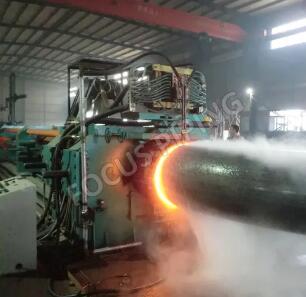May. 10, 2023
Construction & Real Estate
Hot Induction Bends (HIB) are an important component in the construction of pipelines used in the oil and gas industry. HIB provide numerous benefits in terms of efficiency, safety, and cost savings. In this article, we will explore the key advantages of using HIB in pipeline construction.
One of the primary benefits of using HIB is that it eliminates the need for multiple welds that would otherwise be required if a straight pipe had to be welded to make a bend. This significantly reduces the risk of leaks and failures, leading to a safer and more reliable pipeline system. Welding is a time-consuming process that requires a high degree of skill and accuracy. The more welds that are required, the greater the risk of human error, which can lead to leaks and other problems. By using HIB, pipeline manufacturers can significantly reduce the number of welds required, thereby reducing the risk of leaks and failures.

Another advantage of using HIB is that it provides a smooth, gradual bend that helps maintain consistent flow rate and reduces pressure drop. When a pipe is bent, the flow of the fluid inside the pipe is affected. In traditional pipe bending techniques, the bend is typically created by cutting and welding the pipe. This can create a sharp bend that can disrupt the flow of the fluid and cause pressure drops. HIB, on the other hand, provide a smooth, gradual bend that maintains a consistent flow rate and reduces pressure drops. This leads to improved pipeline efficiency, which can result in significant cost savings in terms of energy consumption and pump maintenance.
HIB can also be customized to fit any pipeline project, including varying diameters and angles. This provides more flexibility and enables a more precise fit for pipelines that have a challenging route. Traditional pipe bending techniques are often limited in terms of the angles and diameters that can be achieved. This can be a problem when dealing with pipelines that have to navigate through complex terrain. HIB, however, can be customized to fit any pipeline project, regardless of the angles and diameters required. This makes them an ideal choice for pipeline projects that require a high degree of precision.
Another advantage of using HIB is that they are strong and durable. HIB are made of high-quality steel and can withstand high pressure, stress, and harsh environmental conditions. They also have excellent fatigue resistance, reducing the risk of failure due to repeated loading and unloading. In the oil and gas industry, pipelines are subjected to a wide range of stresses and environmental conditions. HIB provide a high degree of durability and strength, which makes them an ideal choice for pipeline construction.
HIB can also be produced faster than other bending techniques, reducing lead time and ensuring timely project completion. Traditional pipe bending techniques can be time-consuming and labor-intensive. HIB, on the other hand, can be produced much faster, which can help to reduce lead times and ensure that projects are completed on time. This is particularly important in the oil and gas industry, where delays can be costly.
Suggested reading:
Finally, the use of HIB can result in cost savings. HIB can be produced in larger quantities and require less material, reducing production costs. Additionally, the elimination of welds reduces labor costs and potential repairs in the future. The use of HIB can also result in energy savings, which can result in significant cost savings over the life of the pipeline.
In conclusion, the use of Hot Induction Bends in pipeline construction provides a safer, more efficient, and cost-effective solution for the oil and gas industry. The key advantages of using HIB include the elimination of multiple welds, increased flow efficiency, customizability, durability, faster production times, and cost savings. These benefits make HIB an ideal choice for pipeline manufacturers who are looking for a reliable and efficient way to construct pipelines that are strong.
If necessary, please read more related articles:
Drainage Pipes: Efficient Water Management Solution
Why Do Metal Corrugated Pipes Undergo Solid Fusion Treatment?
Related Articles
If you are interested in sending in a Guest Blogger Submission,welcome to write for us!
All Comments ( 0 )